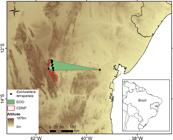Abstract
Eschweilera tetrapetala is a tree endemic to Submontane Seasonal Forests in inland Atlantic forest areas of the Chapada Diamantina Mountains, Northeastern Brazil. The effects of climate change on the spatial distribution pattern of that species were investigated to identify priority areas for its conservation. Distribution patterns and population densities were obtained by sampling individuals in ten 200 x 10 m transects, and in thirty additional 10 x 10 m border and interior forest plots. The occurrence data were subjected to Ecological Niche Modelling using Bioclim, Maxent, and Support Vector Machine algorithms. The predicted model for the current distribution of E. tetrapetala, using the Bioclim, Maxent, and Support Vector Machine algorithms, evidenced stable areas of strong environmental suitability in the east of the Chapada Diamantina. The models also show an expansion of areas with environmental suitability during the Mid-Holocene, with retraction in the present and greater reductions predicted in future global warming scenarios. The number of individuals in the plots varied from zero to 14, indicating an aggregated distribution. Morisita’s index indicated a random distribution along a forest edge but aggregated in the forest interior. Eschweilera tetrapetala is sensitive to climatic change and anthropogenic pressure, at both regional and local scales.
Key words
climatic suitably; forest edge effects; IPCC; Holocene; spatial clustering

 Thumbnail
Thumbnail
 Thumbnail
Thumbnail
 Thumbnail
Thumbnail
 Thumbnail
Thumbnail
 Thumbnail
Thumbnail




